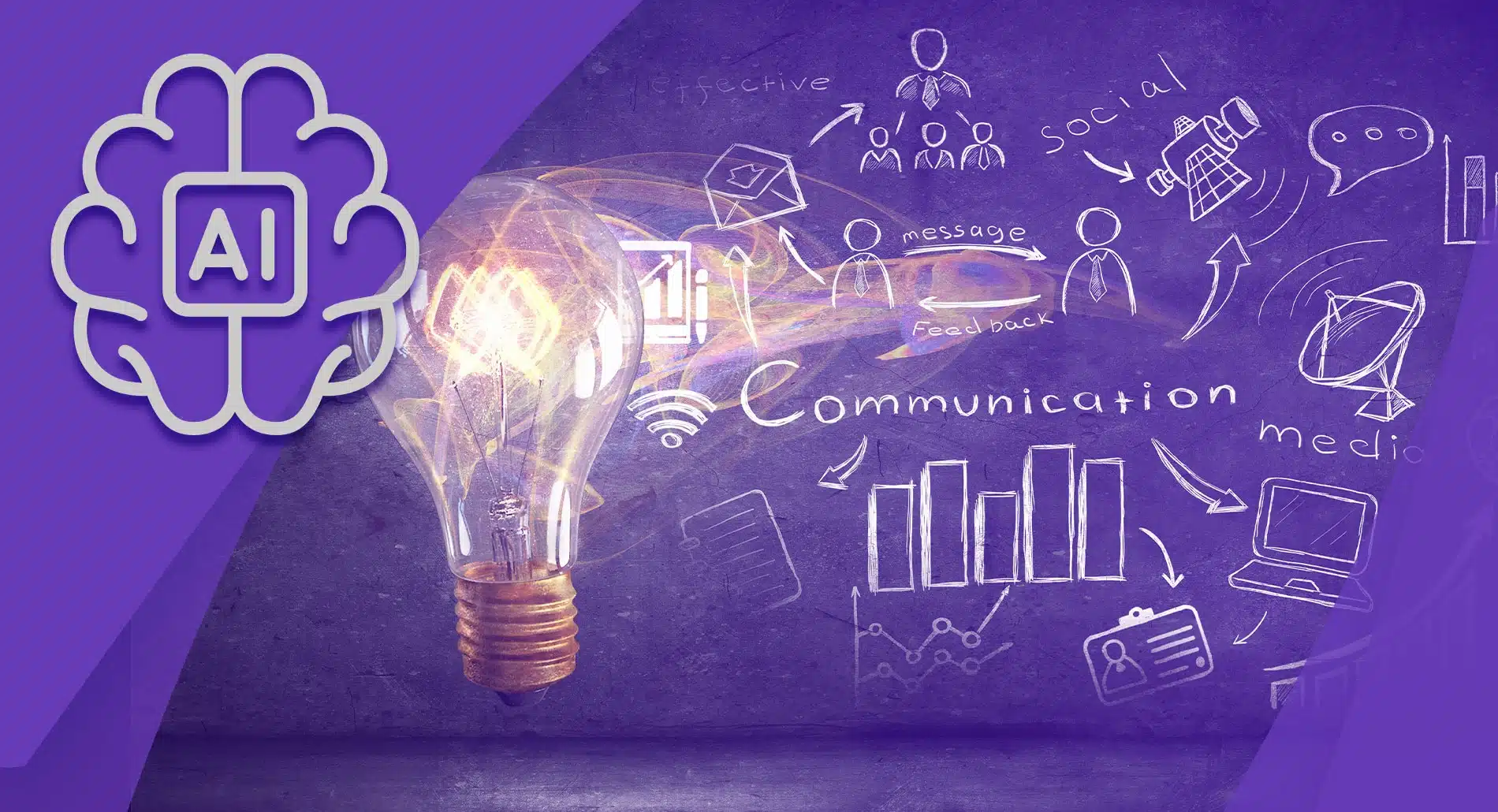As the number of small businesses increases, it’s becoming more challenging to stand out from the crowd. With supply far exceeding demand in our consumerist society, it’s all the more important for SMBs to build unique brands and maintain strong relationships with their clients.
As a marketing agency owner, you’re well aware of all the hard work that goes into building a robust brand, from building a website to consistently engaging with prospects and customers through various digital channels. If your agency doesn’t have a ton of resources, you might quickly find your employees overwhelmed.
Luckily, a wide range of AI tools has emerged to help marketing agencies like yours meet the growing demand for high-quality marketing amidst the ever-intensifying competition. This blog will explore top marketing AI use cases to help you expand your AI tech stack.
Everything you need to market, sell, bill, and fulfill—all in one place
What Is AI in Digital Marketing?
To start, let’s take a closer look at what AI is. According to FTC, AI is an umbrella term for “tools and techniques that use computation to perform tasks such as predictions, decisions, or recommendations.”
AI is powered by CPUs (and often GPUs or specialized AI chips), where it is trained before running on servers in the cloud or various smart devices.
In the context of digital marketing, AI refers to AI software that enables AI marketing automation by performing tasks that previously required human intelligence, such as content generation and data analysis.
AI is essentially a process in which neural networks—composed of a series of algorithms—use machine learning to analyze data, identify patterns, and uncover relationships. In digital marketing, AI generally falls into two categories:
- Reactive AI: This type of AI doesn’t store past data and only executes predefined commands. Examples include Netflix’s recommendation engine, AI assistants that answer product FAQs, and automated email marketing tools.
- Limited Memory AI: This AI analyzes past data to make predictions and inform decisions. Common marketing applications include ChatGPT and AI-powered web chat tools.
Another way to classify AI in digital marketing is based on its function:
- Encoder models: These AI models process and compress information to extract meaning. For example, they can analyze an article to determine its topic.
- Decoder models: These models generate outputs based on encoded data, such as creating marketing content, writing ad copy, or personalizing email campaigns.
Why Should Agencies Use AI in Their Marketing Processes?
Large language models (LLMs), once limited to the data they were trained on, have evolved into more autonomous AI agents. Unlike traditional AI, these agents can now independently assess challenges, gather the necessary information, and determine the best way to execute tasks.
This shift means the conversation is no longer about AI vs. human intelligence but about how AI enhances productivity and streamlines workflows.
To better understand AI’s role in marketing, it’s helpful to differentiate between fixed and dynamic AI workflows:
- Fixed AI workflows follow a predefined process to execute specific tasks, such as scheduling social media posts or sending automated emails.
- Dynamic AI workflows analyze problems in real-time, break them down into sub-tasks, devise a plan, evaluate different solutions, and make adjustments when necessary.
Saves Time by Automating Repetitive Tasks
Fixed AI workflows are ideal for handling manual marketing tasks, such as scheduling newsletters or posting on social media at predetermined times.
This automation frees up employees to focus on higher-priority activities, such as refining marketing strategies and engaging with clients, rather than logging into multiple accounts to publish content manually.
Improves Client Satisfaction Through Personalization
According to Statista, U.S. customers recognize the value of AI in marketing, with personalization being the most significant benefit. Recommendation engines, for example, have become an integral part of daily life—whether suggesting the next movie to watch or recommending complementary products during an online shopping session.
- Fixed AI workflows enable SMBs to deliver personalized experiences, such as sending automated birthday discounts or promotional offers tailored to individual customer preferences.
- Dynamic AI workflows take personalization a step further, enabling AI-powered chatbots to recommend products or services based on a visitor’s past interactions with a website.
Provides Data-Driven Insights to Optimize Marketing Strategies
AI eliminates the need for manual data analysis by collecting and organizing key performance indicators (KPIs) across multiple digital channels.
- Fixed AI workflows consolidate marketing metrics into user-friendly dashboards, making performance tracking more efficient.
- Dynamic AI workflows analyze this data to assess campaign effectiveness, suggest improvements, and even conduct a competitive analysis to help agencies refine their strategies to stay ahead of industry trends.
By leveraging both fixed and dynamic AI workflows, agencies can improve efficiency, enhance client satisfaction, and make data-driven decisions that drive better marketing results.
15 Marketing AI Use Cases for Digital Marketing Agencies
1. Content Creation and Personalization
If your agency specializes in a marketing niche, your team may eventually struggle to generate fresh content ideas. On off days, they might find it challenging to brainstorm engaging headlines or craft compelling copy. Budget constraints may also prevent hiring graphic designers for blog and social media visuals.
In these cases, generative AI can be a game-changer. AI-powered tools—such as Vendasta’s AI-powered social media management software—can analyze client branding and generate tailored social media posts and images.
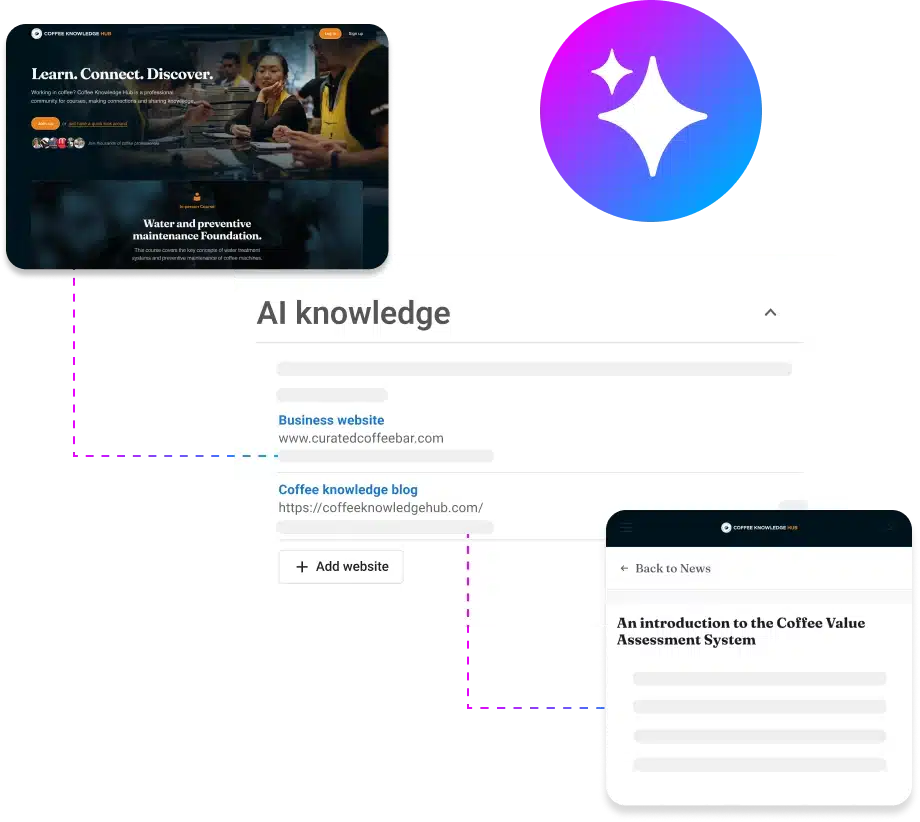
For image generation, tools like DALL·E 3, Midjourney, and Adobe Firefly are leading options. Meanwhile, Jasper AI and ChatGPT are great for content writing.
Implementation Tip
While AI accelerates content production, human oversight is still essential. AI-generated visuals, for instance, often contain imperfections (e.g., incorrect finger counts in human depictions).
Another key consideration is labeling AI-generated content. Governments worldwide are introducing policies to mitigate AI-related biases, misinformation, and copyright concerns. For example, the EU’s December 2023 AI Act mandates that AI-generated content be identifiable and traceable.
To address this, companies like Google have introduced tools like SynthID, which embeds digital watermarks into AI-generated images.
2. Social Media Monitoring and Sentiment Analysis
Managing dozens of social media accounts can make it difficult for agencies to track every comment, question, and review. AI simplifies this process.
- Fixed AI workflows detect anomalies, such as sudden spikes in brand mentions, alerting social media teams to potential crises.
- Natural Language Processing (NLP) enables AI to analyze text sentiment, using rule-based scoring or machine learning to assess overall tone.
Implementation Tip
AI still struggles with nuanced emotions, such as sarcasm or mixed sentiments (e.g., a customer liking one aspect of a service but disliking another). Ensure your team double-checks AI-suggested responses before engaging with customers.
3. Customer Insights and Behavior Analysis
“Know your customer” is a fundamental principle in marketing. But how do you achieve this when managing multiple clients with vast customer bases?
AI-powered CRMs provide the answer. If your agency resells white-labeled CRM software, your clients can centralize lead tracking and customer management.
With fixed and dynamic AI workflows, agencies can:
- Automatically capture lead data
- Score leads based on conversion likelihood
- Trigger automated emails or texts based on customer actions (e.g., booking an appointment)
- Recommend cross-sells and upsells based on past purchases
Implementation Tip
Choose an integration-friendly CRM to ensure smooth compatibility with your existing tools. While platforms like Zapier can bridge gaps, a natively integrated solution—such as Vendasta’s CRM—offers seamless functionality within a broader white-label Marketplace.
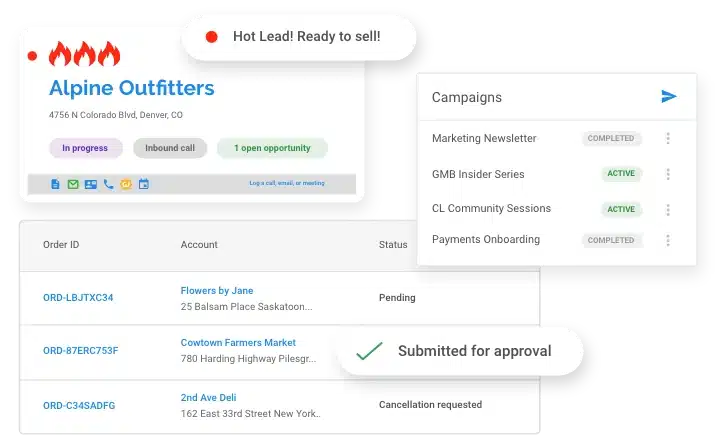
Vendasta empowers your agency to diversify its offerings through white-label solutions as your revenue and client base grow.
4. Predictive Analytics for Campaign Success
AI enhances marketing predictions by analyzing massive datasets to identify behavioral trends. It can forecast:
- The best time to post for maximum engagement
- Whether a piece of content will go viral
- Which ad variations will generate higher conversions
- Whether a specific influencer will boost brand awareness
Implementation Tip
To get the most out of AI-powered predictive analytics, ensure your agency:
- Uses high-quality, diverse datasets: AI models are only as good as the data they’re trained on. Ensure your data sources are comprehensive and up to date.
- Continuously monitors AI predictions: AI-generated forecasts improve over time with new data. Regularly analyze predictions against real-world outcomes to refine your marketing strategies.
- Leverages AI-driven A/B testing: Test different campaign elements (headlines, visuals, audience segments) based on AI recommendations to validate effectiveness before full deployment.
By implementing these strategies, your agency can make data-driven decisions, optimize campaign performance, and stay ahead of industry trends.
5. Chatbots and Customer Service Automation
Today’s consumers expect instant responses. If your SMB clients can’t address inquiries quickly, potential customers may turn to competitors. AI-powered chatbots fill this gap by providing 24/7 support.
Implementation Tip
If you don’t have the resources to build chatbots from scratch, no worries! You can easily resell white-labeled AI-assisted web chats, like Vendasta’s, to meet the growing demand.
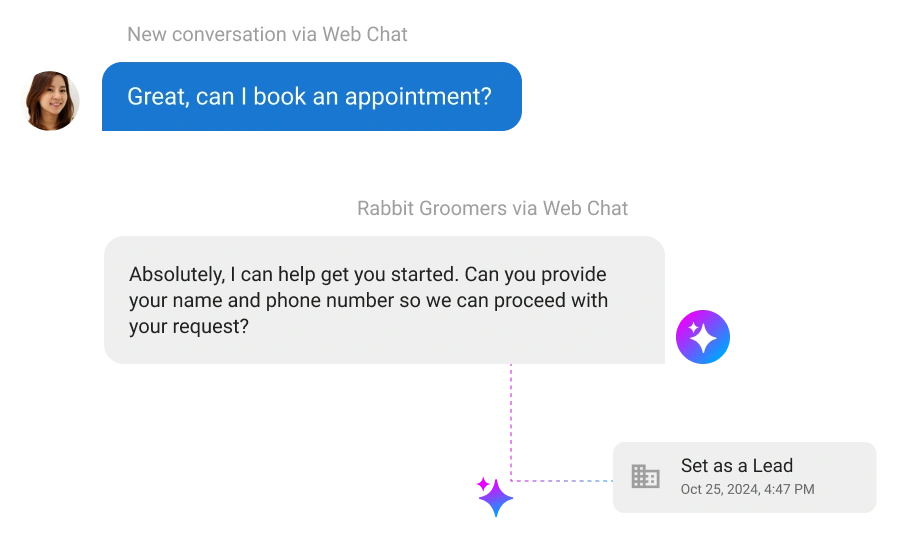
When selecting a provider, ensure:
- Strict data privacy standards to prevent AI-related security breaches
- Compliance with GDPR by collecting only the minimum necessary customer data
- Clear contracts that outline data protection responsibilities
6. Email Marketing Optimization
Email marketing is one of the most cost-effective marketing strategies available to you. Can you make it even more effective? Yes, you can—with AI-powered email marketing platforms.
AI makes email marketing even more effective by:
- Generating campaign sequences and writing engaging copy
- Segmenting audiences based on demographics and behavior
- Analyzing engagement data to optimize send times
- Automating follow-ups for improved retention
Implementation Tip
For clients operating in the EU, ensure your AI email marketing platform complies with GDPR and the Privacy and Electronic Communications Directive.
7. Advertising Targeting and Spend Optimization
AI has been a core component of PPC (pay-per-click) advertising long before the AI boom sparked by ChatGPT. One of the most well-known examples is Google Ads, which uses AI to help businesses reach potential customers at optimal times.
AI enhances PPC campaigns by identifying users who are actively searching for specific products or services, making them more likely to convert. It also excels at audience segmentation, classifying users based on:
- Demographics (age, gender, income)
- Geography (location-based targeting)
- Interests (past browsing behavior)
- Device type (mobile, desktop, tablet)
- Contextual signals (keywords, browsing history)
AI-powered machine learning algorithms adjust bids in real-time to maximize conversions while staying within budget.
Implementation Tip
Running PPC campaigns for dozens of clients might get time-consuming for your digital marketing strategists. Think of all the time it takes to pull the data about the performance of each campaign, format this data into a dashboard for client reporting, and prepare for a client meeting on top of that.
White-labeled marketing software, such as Vendasta MatchCraft, empowers marketing agencies to efficiently create PPC campaigns for multiple clients with the help of AI-generated, merchant-specific ads, and keywords and to manage them under one roof seamlessly.
Also, through Vendasta’s white-labeled client portal, Business App, your customers can see the performance of their marketing campaigns in real-time.
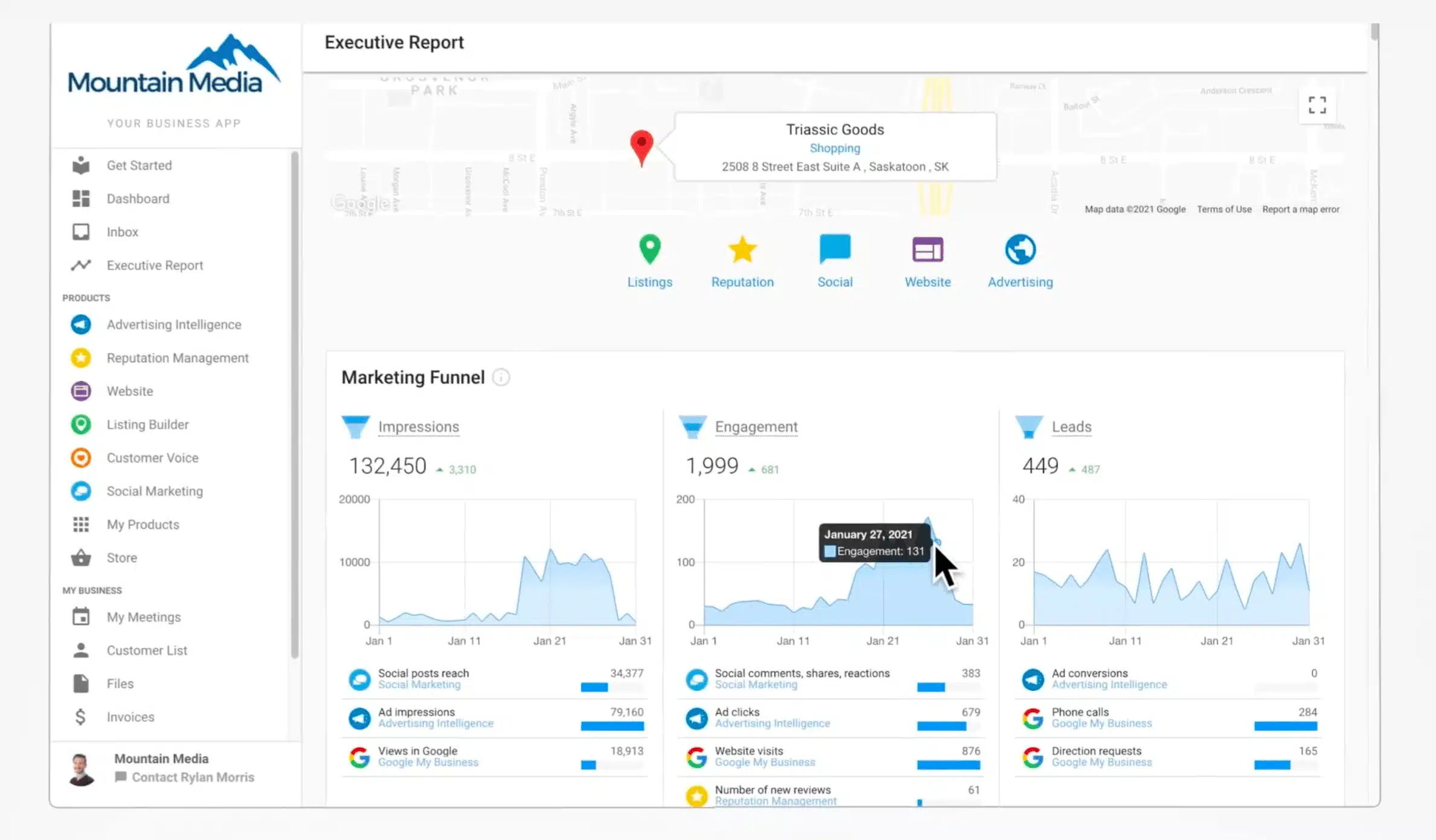
8. Dynamic Pricing Strategies
If your agency serves automotive companies, hotels, or eCommerce businesses, dynamic pricing is one of the most impactful AI marketing use cases to consider.
When implemented correctly, dynamic pricing allows your clients to:
- Maximize profitability by adjusting prices in real-time based on demand
- Enhance customer trust by providing transparent pricing trends
For example, hotels can show price trends for different seasons, encouraging early bookings while assuring guests they’re getting the best possible deal. Similarly, automotive dealerships can adjust vehicle pricing based on inventory levels, competitor prices, and consumer demand.
Implementation Tip
To ensure the successful adoption of dynamic pricing, consider the following:
- Using AI-powered pricing software that integrates with your clients’ existing inventory management systems.
- Setting pricing rules to avoid extreme fluctuations that could frustrate customers.
- Regularly monitoring AI-driven adjustments to ensure pricing aligns with overall business objectives.
Dynamic pricing works best when paired with real-time analytics to provide insights into pricing effectiveness and customer responses.
9. Image and Video Recognition for Marketing
AI-powered visual analysis enables marketers to process and understand images and videos at scale. This technology is powered by deep learning algorithms, specifically Convolutional Neural Networks (CNNs), which extract features such as:
- Shapes
- Colors
- Patterns
- Textures
By analyzing historical data and real-time inputs, AI can detect visual trends, helping agencies create aesthetic styles that resonate with target audiences.
Here’s an example: On YouTube, TikTok, and Instagram, thumbnails play a crucial role in click-through rates (CTR). AI tools analyze millions of thumbnails to determine which designs attract the most engagement, providing insights that guide optimized video marketing strategies.
Implementation Tip
To get the most value from AI-driven image and video recognition:
- Use AI tools to analyze engagement trends on social media and video platforms.
- Leverage AI-generated insights to optimize ad creatives, thumbnails, and video content.
- Test AI-generated visuals against human-created ones to find the best-performing designs.
AI-powered visual analysis ensures marketing campaigns remain visually compelling and aligned with audience preferences.
10. Lead Scoring and Sales Forecasting
Manually reviewing every prospect interaction for each client is impractical. AI automates lead scoring by analyzing engagement data from multiple sources, including:
- Website visits
- Social media interactions
- Email opens and click-through rates
Using predictive modeling, AI determines which leads are most likely to convert and flags high-priority prospects for your sales team. This improves sales efficiency and helps focus efforts on leads with the highest potential ROI.
Implementation Tip
For effective AI-driven lead scoring and forecasting, ensure:
- CRM integration to automatically capture and update lead data.
- Regular adjustments to scoring criteria based on AI insights.
- AI-driven outreach automation to personalize follow-ups with high-priority leads.
By combining lead scoring with predictive analytics, agencies can improve conversion rates and optimize sales strategies.
11. A/B Testing Automation
Traditional A/B testing required significant manual effort to set up, monitor, and analyze. AI accelerates this process by:
- Automatically generating multiple variations of ads, emails, or landing pages.
- Analyzing past performance data to create tailored designs and messaging.
- Dynamically adjusting tests in real-time based on audience response.
AI can also use predictive modeling to forecast which variations will perform best, optimizing campaigns before full deployment
Implementation Tip
To maximize the effectiveness of AI-driven A/B testing:
- Test multiple elements (headlines, CTA buttons, ad visuals) simultaneously.
- Use AI to segment audiences for better personalization.
- Regularly review AI-generated results to refine marketing strategies.
AI-driven A/B testing ensures campaigns are continuously optimized for maximum engagement and conversion rates.
12. Voice Search Optimization
With the rise of voice assistants like Alexa, Google Home, and Siri, voice search has become an integral part of modern search behavior. To ensure your SMB clients’ content is optimized for voice-driven queries, consider these key differences from text-based searches:
- Conversational: Voice searches tend to be full-sentence questions rather than short keyword phrases.
- Longer: Queries are more detailed, requiring content that provides clear, direct answers.
- Mobile-Oriented: Many voice searches happen on smartphones, emphasizing local intent.
- Local: Users often seek location-based recommendations (e.g., “best coffee shop near me”).
Implementation Tip
AI-powered SEO tools help agencies adapt content for voice search by:
- Identifying long-tail keywords and question-based phrases (e.g., “How to bake a chocolate cake?” or “What are the symptoms of the flu?”).
- Tracking emerging voice search trends to optimize content for FAQ sections and blog posts.
Here’s an example: if an AI tool detects an increase in queries like “What are the best gluten-free cakes?” a bakery client can integrate this topic into their blog and website content to attract organic traffic.
13. Automated Surveys and Feedback Analysis
With AI tools, you can distribute customer surveys through email, SMS, and social media. AI can also help you optimize your timing to ensure users see them in their mailboxes when they are most likely to engage.
Once the clients answer the surveys, their feedback triggers automated workflows, such as follow-up emails and notifications to your team members.
By the way, your team doesn’t need to spend tons of time analyzing the surveys. AI can do that with the power of sentiment analysis, as we talked about above.
Implementation Tip
If you’re already using Vendasta’s reputation management platform, you’ll be happy to find out that its AI assesses clients’ NPS before requesting a review to amplify positive experiences.
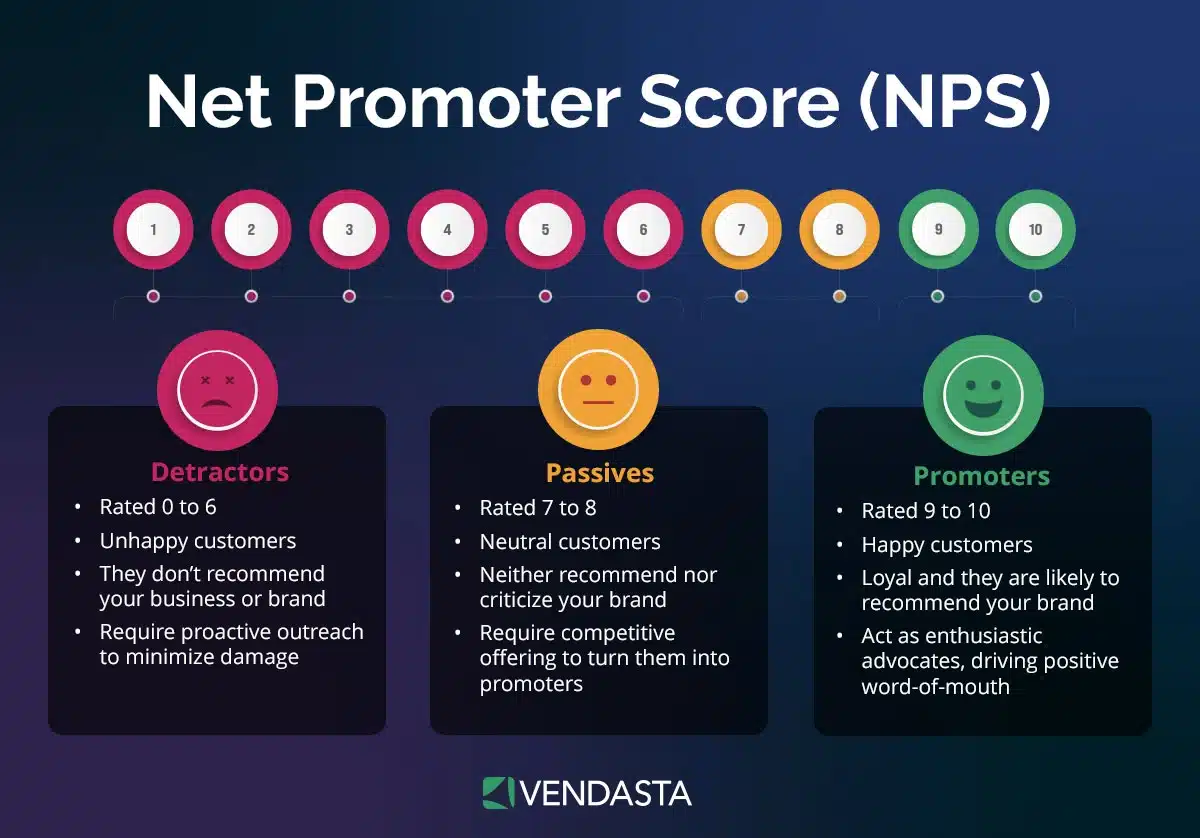
You can build automated workflows based on NPS scores to engage customers with a tailored post-purchase experience at scale.
14. AI-Powered Affiliate Marketing Management
Affiliate marketing is an excellent way for your SMB clients to bring their brand to more eyes. In fact, The State of Influencer Marketing 2024: Benchmark Report predicted that the influencer marketing industry would grow to $24 billion by the end of 2024.
While in the past, your team had to manually search for potential influencers and calculate compensation rates, they can now leverage AI tools to do both.
For example, Delve AI’s Social Persona helps you identify influencers who align with your clients’ target audiences. To do this, the software analyzes user conversations and extracts hashtags, topics, and content types that resonate with them. The software then identifies professionals in the industry who have expert knowledge in related topics. Cool, right?
When it comes to compensation, AI tracks sales, clicks, leads, and other performance metrics in real-time, attributing these actions to the correct affiliate. It supports three main compensation structures:
- Flat-Rate Commissions: Fixed payouts per sale or lead.
- Performance-Based Models: AI calculates variable commissions based on metrics like conversion rates or total revenue generated.
- Tiered Rewards: AI tracks affiliate performance over time and adjusts rates as affiliates achieve milestones (e.g., higher sales tiers).
Implementation Tip
When selecting influencers, beware of fake engagement. Some influencers purchase fake followers or use AI-generated engagement bots. Red flags include:
- Unrelated comments on posts.
- Low engagement rates despite a large follower count.
Use AI tools, such as vHub.ai‘s Fake Influencer Detection Tool, to verify influencer authenticity before committing to partnerships.
15. Customer Journey Mapping with AI
AI enables precise customer journey mapping by analyzing real-time data from multiple sources, including:
- CRM systems
- Social media platforms
- Website analytics
- Customer feedback surveys
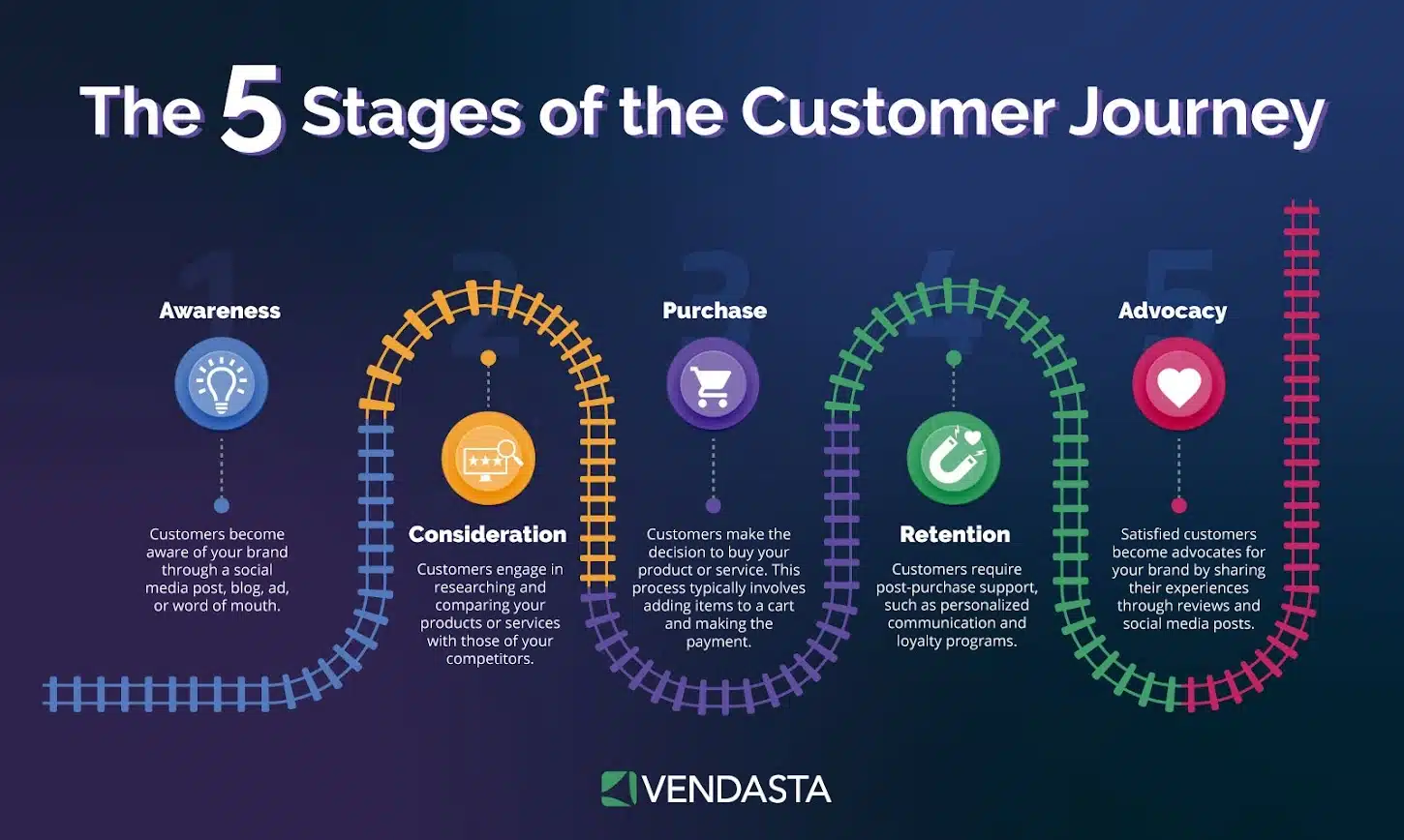
With pattern recognition, AI can:
- Identify common customer behaviors (e.g., frequently visited pages, abandoned carts, repeat purchases).
- Segment audiences based on behavior, preferences, and demographics.
- Forecast future customer actions using historical data.
- Track real-time customer interactions, providing instant insights into key conversion touchpoints.
By leveraging AI-powered customer journey analytics, agencies can refine marketing strategies, optimize touchpoints, and improve overall customer experiences.
Implementation Tip
To successfully implement AI-powered customer journey mapping:
- Ensure all customer data sources are integrated for a holistic view.
- Use AI insights to adjust marketing automation workflows based on customer behavior.
- Personalize engagement strategies by tailoring content, offers, and messaging to each journey stage.
With AI-powered customer journey mapping, agencies can deliver highly personalized experiences and improve overall marketing performance.
Why Vendasta Is the Ideal AI Partner for Marketing Agencies
Vendasta provides a comprehensive platform designed to empower marketing agencies, just like yours, to deliver the best marketing results to their SMB clients. Here’s why Vendasta is an ideal choice:
- AI Workforce: Vendasta’s AI employees can help with prospecting and lead nurturing, content creation and optimization, reputation management, and more.
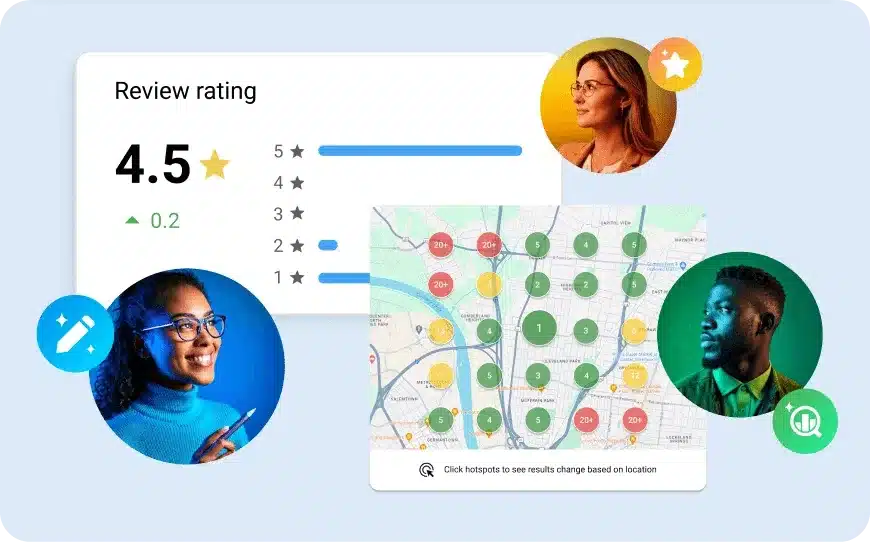
- Unique Business Data: With Vendasta, agencies can make the most use of their proprietary data, such as customer purchase history and behavioral patterns, to create highly tailored marketing campaigns.
- Smart Automations: Vendasta’s platform automates various marketing tasks, including campaign management, client engagement, and social media publishing.
- Seamless Partner-SMB Collaboration: Vendasta’s shared dashboards foster transparent communication and close collaboration between marketing agencies and SMBs.
- Integrated Marketing and Operations Suite: Unlike standalone tools, Vendasta offers an all-in-one solution for running digital marketing campaigns, automating workflows, and delivering personalized customer journeys.
Are you ready to implement marketing AI use cases and boost the success of your SMB clients? Explore Vendasta’s AI tools or request a demo today!
AI Marketing Use Cases FAQs
1. What are the top marketing AI use cases for agencies?
AI empowers marketing agencies to streamline processes and enhance campaign performance. Key use cases include:
- Automating repetitive tasks
- Personalizing campaigns
- Optimizing SEO strategies
2. How can AI improve marketing efficiency?
AI tools automate time-consuming tasks like campaign reporting and content distribution. For example, Vendasta’s Executive Report consolidates client data about the performance of different marketing campaigns, generating automated reports.
3. Can AI help retain clients?
AI provides valuable insights into client behavior and satisfaction, enabling agencies to address issues proactively and foster loyalty.
4. What are the best marketing AI tools for agencies?
A variety of marketing AI use cases cater to different aspects of marketing. The top recommendations are:
- Vendasta: Automation, reporting, and comprehensive campaign management.
- SEMrush: SEO strategy and competitive analysis.
- Hootsuite: Social media management and scheduling.
- HubSpot: Marketing automation and CRM integration.
5. How can small or mid-sized agencies afford AI tools?
AI tools are becoming more and more accessible, even for smaller marketing agencies, thanks to scalable pricing models and value-driven solutions:
- Scalable options: Many AI tools offer tiered pricing to accommodate various budget levels.
- Vendasta’s approach: Bundled solutions maximize marketing automation ROI, making it easier for marketing agencies to leverage powerful AI capabilities without overspending.
6. What’s the difference between fixed and dynamic AI workflows?
Fixed AI follows preset rules to automate tasks like scheduling posts or sending emails. Dynamic AI analyzes real-time data, plans steps, and adapts—great for optimization and personalization. Most agencies benefit from combining both to scale execution while improving outcomes.
7. How do I start using AI marketing at a small agency?
Begin with high-impact wins: automate reporting, build reusable content templates, and add web chat. Vendasta helps you launch quickly with AI employees, integrated CRM, and white-label tools—so you can deliver results fast without stitching together multiple platforms.
8. Do I need a CRM to use AI for lead scoring?
Yes—AI needs centralized, clean data to score leads accurately. A CRM unifies website, email, and ad interactions so models can predict conversion likelihood. Vendasta’s CRM pairs with automations to trigger timely outreach and move high-intent prospects down-funnel.
9. How can AI improve PPC campaign performance?
AI analyzes intent signals, adjusts bids, and tests ad variations in real time. With Vendasta’s MatchCraft, agencies generate merchant-specific keywords and ads at scale, manage accounts centrally, and use automated insights to reduce waste while increasing conversions.
10. Can AI help agencies turn marketing insights into action?
Absolutely. AI doesn’t just collect data—it recommends the next step. Vendasta’s platform consolidates client performance metrics, then suggests optimizations or triggers automated workflows, making it easier for agencies to translate insights into measurable growth.

